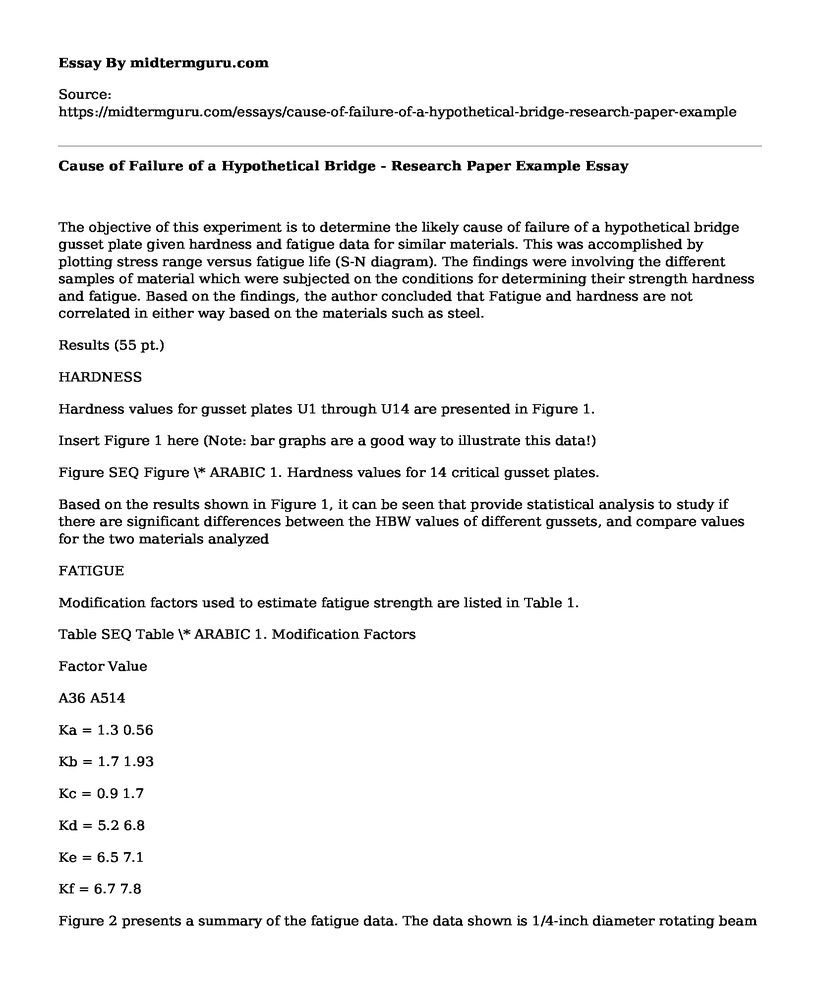The objective of this experiment is to determine the likely cause of failure of a hypothetical bridge gusset plate given hardness and fatigue data for similar materials. This was accomplished by plotting stress range versus fatigue life (S-N diagram). The findings were involving the different samples of material which were subjected on the conditions for determining their strength hardness and fatigue. Based on the findings, the author concluded that Fatigue and hardness are not correlated in either way based on the materials such as steel.
Results (55 pt.)
HARDNESS
Hardness values for gusset plates U1 through U14 are presented in Figure 1.
Insert Figure 1 here (Note: bar graphs are a good way to illustrate this data!)
Figure SEQ Figure \* ARABIC 1. Hardness values for 14 critical gusset plates.
Based on the results shown in Figure 1, it can be seen that provide statistical analysis to study if there are significant differences between the HBW values of different gussets, and compare values for the two materials analyzed
FATIGUE
Modification factors used to estimate fatigue strength are listed in Table 1.
Table SEQ Table \* ARABIC 1. Modification Factors
Factor Value
A36 A514
Ka = 1.3 0.56
Kb = 1.7 1.93
Kc = 0.9 1.7
Kd = 5.2 6.8
Ke = 6.5 7.1
Kf = 6.7 7.8
Figure 2 presents a summary of the fatigue data. The data shown is 1/4-inch diameter rotating beam specimens and have been modified according to the characteristics of the critical I-35 gusset plate.
Figure SEQ Figure \* ARABIC 2. Comparison between modified bending beam fatigue tests and critical I-35 gusset plate at time of failure.
Lab Questions (30 pt.)
Is there a definitive relationship between hardness, fatigue life, and yield strength? Explain.
There is no definitive relationship between the three as relativity among them differs depending on the material as well as the value of the Ultimate/ Yield tensil strength. For instance. It is basic principle of thumb that, for steels allowing a UTS below 160,000 psi, the limit strength for the UTS material will be between 45 to 50% when the surface for the test specimen is polished and smooth. Therefore, that relationship is depicted by the line named "50%". An insignificant number of exceptional case material may possibly maintain the roughly 50% relationship beyond the 160,000-psi level.
Though, the EL of many steel starts to collapse away from the 50% line beyond a UTS of nearly 160,000 psi as demonstrated by the line named "Polished".
Can a hardness number be used to determine a materials yield strength? Explain?
The connection between the materials strength and its hardness can be determined theoretically:
H=c
H= hardness in kg/mm2
= strength of the yield in MPaWhereby c is the elastic constrain factor and nearly equal to 3 for matters that do not hardly strain.
For ferritic steels, the correlation is as follow:
y=H30.1n
Given that, n is the strain hardening proponent.
Therefore, the strength of the yield can be approximated from the strength by ways of experiential relationship.
When comparing experimental fatigue values to those expected for actual structural members, why must so many modification factors be used? What are the limitations of this approach? How could you avoid these assumptions?
Since to the fatigue values are natural statistical, and determined on improved, laboratory tests, proper design exercise needs the willpower of the actual fatigue will be for every particular application, referred to as APPLICATION-SPECIFIC ENDURANCE LIMIT (ASEL).
Sequentially to design for satisfactory fatigue life, good practice needs the reduction of the laboratory Endurance Limit value by numerous adjustment aspect. The reduction is essential to account for:
The identified statistical difference for the materials; and the distinction between the testing and the application environment.
How do the hardness values compare with those for ASTM A36 steel? A metallurgical examination of gusset U9 indicates it may be made of ASTM A514 (quenched and tempered) steel. Do your findings support or contradict?
Is it possible to design a mechanical or structural component for an infinite fatigue life? Is it possible to design a component that can outlast the service life of the structure? Explain.
Yes, it is absolutely possible for some iron as well as aluminum alloys if the application of the steel amplitude fails to surpass the strength of endurance in the materials.
In your expert opinion, what was the cause of failure of the I-35 Bridge? Be SPECIFIC!
The cause of the failure of the I-35 Bridge? Was the high pressure that was exerted at the steel of the causing its contraction as well as fatigue.
Conclusions (10 pt.)
The original objective of this experiment was to determine the likely cause of failure of a hypothetical bridge gusset plate given hardness and fatigue data for similar materials. Based on the above results, the author determined that the strength pf the steel and how hardness and fatigue affects the strength pf the steel.
Cite this page
Cause of Failure of a Hypothetical Bridge - Research Paper Example. (2021, Jun 17). Retrieved from https://midtermguru.com/essays/cause-of-failure-of-a-hypothetical-bridge-research-paper-example
If you are the original author of this essay and no longer wish to have it published on the midtermguru.com website, please click below to request its removal:
- Summary of the Egypt Builds by Elshahed
- Oil and Gas Industry Training Issues
- Effects of Mountaintop Coal Mining and the Deepwater Horizon Oil Spill - Paper Example
- Reducing H2S in Khurmala Oil Field by Using Different Kind of Chemicals - Paper Example
- Factors Contributing to the Successful IT-Management Control System Integration in Oil and Petrochemical Industry
- Engineering Management Admission - Essay Sample
- Urban Transformation in Addis Ababa: Rapid Development, Limited Progress - Essay Sample







